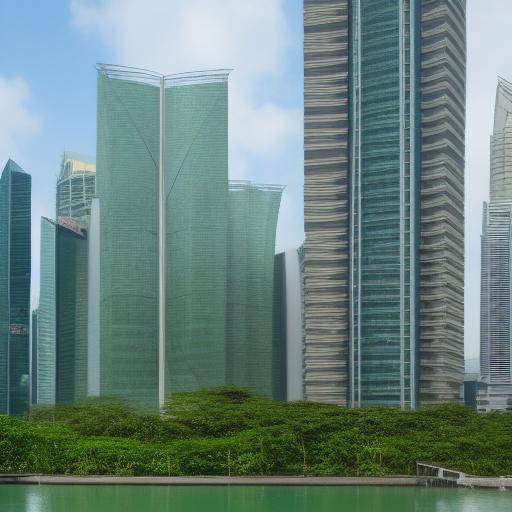
In Singapore's bustling city, the fusion of nature and architecture has created biophilic buildings that are impressive examples of sustainable design. Vertical gardens, inner waterfalls and sustainable design have transformed the urban landscape, generating environments that positively impact people's lives. In this article, we will explore five biophilic buildings in Singapore that exemplify this merger and how these concepts have been implemented to improve the quality of life in urban environments.
Introduction
Singapore, a city known for its innovation and dazzling architecture, has taken a step forward in sustainability and harmony with nature by incorporating biophilic elements into its flagship buildings. These buildings go beyond mere structures and become sensory experiences that integrate nature into urban life. In this article, we will explore five emblematic buildings that have achieved this unique fusion of nature and architecture, using vertical gardens, interior cascades and sustainable design to create spaces that inspire and nourish.
History and Background
The Biophilic Movement
The concept of biophilia, which refers to the innate connection of human beings with nature, has gained relevance in architecture and urban design. As cities grow, it has become crucial to reintegrate nature into the built environment to counteract the environmental impact and improve the quality of life of urban inhabitants.
Evolution of Biophilic Architecture in Singapore
Singapore has led the way in integrating biofill architecture into urban environments. From its first pioneer projects to the current innovative structures, the city has demonstrated a continuous commitment to sustainable architecture that incorporates natural elements.
Deep analysis
Benefits of Vertical Gardens and Inner Waterfalls
The integration of vertical gardens and indoor waterfalls into biophilic buildings not only improves aesthetics, but also entails tangible benefits for the environment and quality of life of urban inhabitants. Vertical gardens act as carbon sinks, improve air quality and provide shelter for wildlife, while indoor waterfalls improve air quality and generate a serene and relaxing environment.
Sustainable Design Challenges in Urban Environments
Although sustainable design has gained ground in contemporary architecture, it faces unique challenges in urban environments. Space management, material selection and the integration of efficient systems require an innovative and collaborative approach to ensure that biophilic buildings are truly sustainable in the long term.
Exhaustive examination
Applications Vertical Gardens Practices, Interior Waterfalls and Sustainable Design
Vertical gardens, indoor waterfalls and sustainable design have been applied in a variety of contexts, from residential skyscrapers to commercial complexes and public spaces. These examples highlight the versatility and adaptability of biophilic elements in creating living and sustainable environments.
Industry Perspectives and Expert Reviews
Industry leaders and architectural and design experts share their perspectives on integrating nature into urban architecture. Their views shed light on emerging trends, current challenges and future opportunities in the field of biophilic architecture.
Conclusions and FAQs
Conclusions
Biophilic buildings in Singapore represent a significant development of sustainable architecture and the integration of nature into urban environments. Its impact goes beyond the aesthetic, directly addressing the environmental and emotional needs of urban communities.
Frequently asked questions
What benefits do vertical gardens bring to urban buildings?
Vertical gardens provide benefits ranging from improved air quality and reduced heat island effect to the creation of aesthetically attractive spaces and the promotion of biodiversity in urban environments.
How are the interior waterfalls designed to maximize their impact on architectural spaces?
The inner waterfalls are designed taking into account the circulation of the air, natural lighting and acoustics, with the aim of creating a relaxing visual and hearing environment that improves the experience of the occupants of the building.
Why is sustainable design important in contemporary architecture?
Sustainable design in contemporary architecture is essential to reduce the environmental impact of buildings, promote energy efficiency, and create living spaces that respect the natural environment and future generations.
How do biophilic buildings influence the well-being of people who inhabit and visit them?
Biophilic buildings have a positive impact on people's well-being by offering healthier environments, connecting with nature, and promoting relaxation and productivity, which can result in physical and emotional benefits.
What are the key challenges in integrating vertical gardens and indoor waterfalls into dense urban environments?
The main challenges include space management, the selection of suitable plants and materials, and the implementation of irrigation and maintenance systems that ensure the long-term viability of these elements in urban environments.
What are some emerging trends in biophilic architecture and sustainable design?
Emerging trends include the integration of renewable energy systems, the use of ecological materials, and the application of smart technologies to optimize environmental performance and the inhabitability of biophilic buildings.
In conclusion, the integration of vertical gardens, interior waterfalls and sustainable design into biophilic buildings in Singapore exemplifies the possibility of merging nature and architecture harmoniously and sustainably. These inspiring examples not only embellish the urban landscape, but also provide healthier and more nature-connected environments for urban communities. With the continuing commitment to innovate and collaborate in the field of biofill architecture, the future promises a greater integration of nature in urban spaces, transforming the way we live, work and relate to our built environment.
